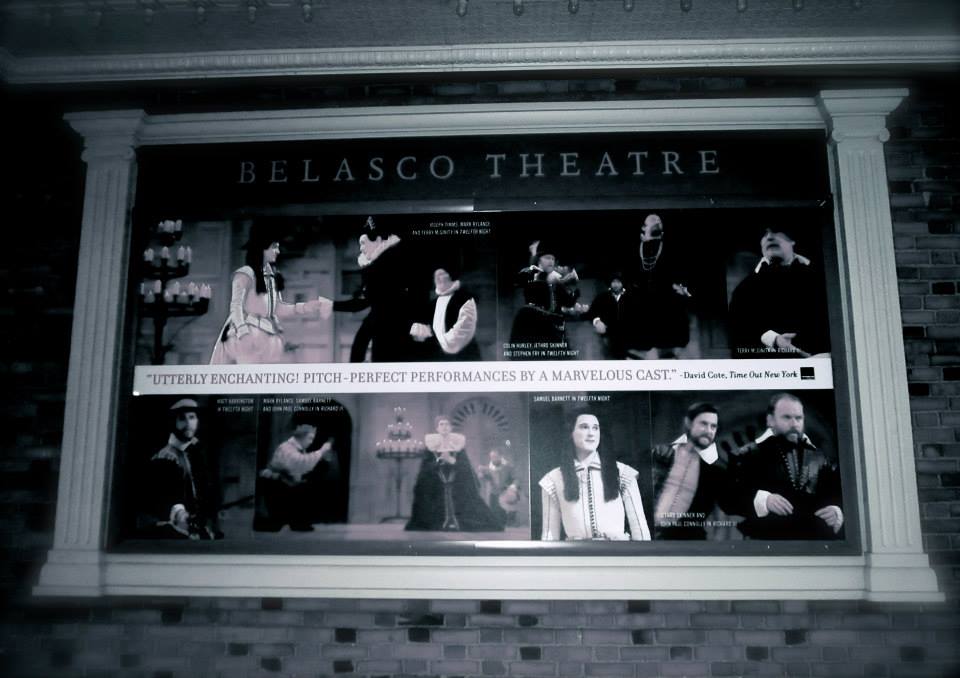If possible, see the Shakespeare’s Globe productions of TWELFE NIGHT and THE TRAGEDIE OF KING RICHARD THE THIRD back to back, on the same day. Go for drinks or dinner in between, make a day of it. It would also be good, budget and availability permitting, to opt for onstage seating for one and house seating for the other. For what the experience of “Shakespeare on Broadway” is about is perspectives, historical and aesthetic, including the desire, however futile, for an unobstructed view of how plays once were done, for theatrical time machines that transport us to ages that we have romanticized out of dissatisfaction with our own. I exclude myself from this quest, not because I have a deep objection to it (some do), but because I think it an impossible one, even while recognizing, always with a caveat, the beauties that it can create along the way.
The shared set for both plays re-creates the sort of university hall in which Elizabethan players might have done their plays when they were not acting in the public playhouses (although it sits on the stage of a theater named after an American producer famous for meticulous but unattainable realism); the costumes have been constructed with the best contemporary equivalents to 16th-century materials (although I wonder about the shoes and the cleanliness of the cloth); the women are played by men as they were in Shakespeare’s day (although by mature players rather than Elizabethan boy actors); the stage is lit by candles (although not really). What one gets, in other words, is an approximation, if an exhilarating one, of how it might have been; an echo, perhaps, of the flow and rhythm posited by a certain mode of staging, or the kind of physical movement that the period costumes permit or encourage.
Even an echo of such a world is something to behold, and the experience of Shakespeare on Broadway is equal parts historical reproduction and theater-in-the-moment, with a particular emphasis on how the Elizabethan practice of men playing women alters our perspective on gender, and on acting itself, today. There are, in point of fact, biological women in the production – among the musicians (whose instruments are billed as the first of their period to appear on Broadway) – but it is still bracing to witness the Noh-like transformation of the male actors into their female roles, leading to a realization, in the case of TWELFE NIGHT, through wry indication and habituated mannerism, of a sort of feminine cultural essence.
Mark Rylance is a rapturously fussy Olivia, with a subtlety of expression, a delicacy of hand and arm, and a sly affection for his own masquerade that exploits the wink and the nod, the stereotyped gesture and its real world basis. No one in the ordinary course of life would mistake Rylance as Olivia, Paul Chahidi as Maria, or Samuel Barnett as Viola for actual women, for longer than a double-take, yet their figuration of the feminine onstage is enthralling. I think that in the comedies in particular, Elizabethan cross-dressing succeeds when it is not fully realistic, when a trace of the underlying sex plays humorously off the outward disguise. Today, it is usually the heroine playing the man that we see, but in this all male cast the pleasure of the masquerade is redoubled upon all the female characters. Rylance and Chaludi glide across the floor in their great dresses, as though on wheeled platforms, like icons in a religious procession, while Barnett delights in the irony of a man playing a woman playing a man who resembles to a tee her twin brother Sebastian, wonderfully acted by Joseph Timms.
When one comes, after that, to RICHARD III, there is a residual memory of it that creates a bitterer sort of irony when Rylance, reborn as the murderous Richard, speaks contemptuously of “women” and targets them, in what feels like some sort of self-loathing pathology, for manipulation and seduction. Timms as Anne and Barnett as Elizabeth are far more mistakable for women on the street than the impersonations in TWELFE NIGHT. I am not sure, were I to walk into the theater benighted, that I would know that they were men. RICHARD THE THIRD is a different sort of drama, with a dimension of the tragic, and so the greater accuracy of their portrayals is both necessary and effective. The confrontation between Rylance’s Richard and Barnett’s Elizabeth in Act IV, desperately laced with wordplay and lies, is, with the foundation of Barnett’s extraordinary act of mimesis, the strongest scene in either of the plays, and among the finest Shakespeare that I have been privileged to see either live or onscreen.
TWELFE NIGHT is the production that I would recommend most on its own, but really, see if you can both of them, in rapid succession, in one order or the other, for the sake of that scene, but mostly for how the two experiences interrelate, creeping the one into the other like ivy, invasive but ever green.
For more on the Shakespeare’s Globe production, click here.
